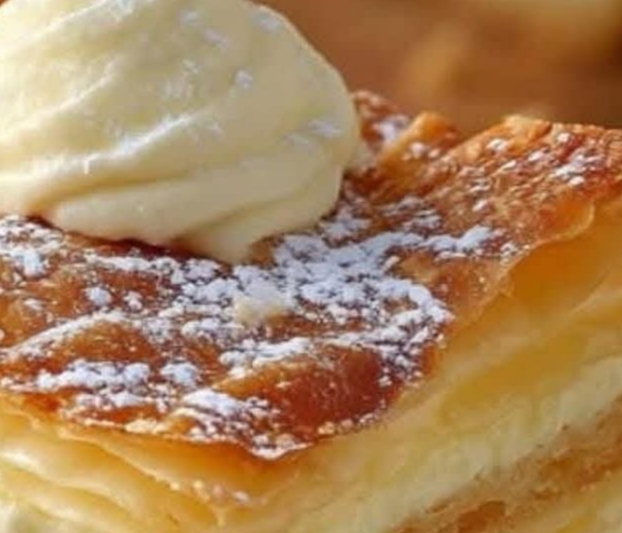Here is a full, detailed recipe profile for Millefeuille: The Classic Recipe for a Fragrant and Delicious Dessert, including every section you requested:
Millefeuille: The Classic Recipe for a Fragrant and Delicious Dessert
Introduction
Millefeuille, also known as the Napoleon, is a delicate and elegant French pastry that delights with its crisp, flaky layers of puff pastry and smooth, sweet cream filling. Its name means “a thousand leaves,” a poetic nod to the pastry’s many fine layers. This classic dessert is both luxurious and surprisingly accessible, making it a perfect choice for special occasions or a sophisticated sweet treat anytime.
Origin and Cultural Significance
Originating in France in the 17th century, Millefeuille has been a symbol of refined patisserie ever since. Traditionally found in Parisian bakeries and European tea salons, this dessert embodies the finesse and artistry of French culinary technique. Over time, variations have emerged across the world, with different creams, fruits, or icings. Its enduring appeal lies in its visual beauty, texture contrast, and celebration of simplicity done exceptionally well.
Ingredients Quantity
- 1 package puff pastry (store-bought or homemade, thawed if frozen)
- 2 cups heavy cream
- ½ cup powdered sugar
- 1 tsp vanilla extract
- 1 tbsp cornstarch
- ¼ cup water
- ½ cup icing sugar (for dusting)
Optional Additions
- Fresh berries (strawberries, raspberries, or blueberries for layering or garnish)
- Lemon zest or orange zest (for a citrus twist in the cream)
- Chocolate drizzle (melted dark chocolate on top for extra decadence)
- Almond flakes or toasted nuts (for garnish and texture)
- Pastry cream or diplomat cream (for a more traditional filling alternative)
Tips for Success
- Keep puff pastry cold before baking to ensure proper rise and flakiness.
- Prick the pastry with a fork before baking to prevent excessive puffing.
- Use a baking sheet on top of the pastry while baking to keep layers flat and even.
- Whip cream to soft peaks for a smooth, stable filling—do not overbeat.
- Chill the assembled dessert for at least an hour before slicing for cleaner cuts.
- Use a serrated knife when slicing to maintain the layered structure.
Instructions
- Preheat oven to 400°F (200°C). Line a baking sheet with parchment paper.
- Roll out puff pastry and cut into three equal rectangles (approx. 10×4 inches each). Prick all over with a fork.
- Place another baking sheet on top to keep the pastry from puffing too high, then bake for 12–15 minutes, or until golden brown. Let cool completely.
- In a bowl, whip the heavy cream with powdered sugar and vanilla extract until soft peaks form.
- Mix cornstarch with water in a small bowl until smooth, then fold gently into whipped cream to help stabilize it.
- Assemble the millefeuille: place one pastry layer on a serving platter, spread a third of the cream over it, then repeat layers. End with the third pastry layer on top.
- Dust the top generously with icing sugar. Optionally, drizzle with melted chocolate or top with berries.
- Chill for 1 hour before serving. Slice with a sharp serrated knife for best results.
Description
This millefeuille offers an elegant interplay of textures: crisp, buttery puff pastry gives way to soft, vanilla-scented whipped cream. Light and luscious, the dessert feels indulgent without being overly heavy. Each bite delivers sweetness, creaminess, and crunch in perfect harmony—a timeless treat that looks as beautiful as it tastes.
Nutritional Information (Per Serving, Approximate; based on 8 servings)
- Calories: 370
- Protein: 3g
- Fat: 27g
- Carbohydrates: 30g
- Sugar: 18g
- Fiber: 1g
- Sodium: 90mg
(Values vary depending on pastry brand and cream used.)
Conclusion
Millefeuille is a classic for a reason—it’s a showstopper that combines simplicity with elegance. Whether you’re hosting a dinner party or just want to treat yourself to something special, this recipe offers a bakery-quality experience right at home. Its creamy filling and flaky crust are always a hit.
Recommendation
Serve chilled with a strong cup of espresso or a light dessert wine like Moscato. For a festive occasion, add fresh berries or a drizzle of raspberry coulis. Leftovers should be stored in the fridge and are best enjoyed within 2 days to preserve texture.
Embracing Healthful Indulgence
This millefeuille is a wonderful example of how indulgence can still be balanced. To lighten the recipe, try using a lower-fat whipped topping or reduce the sugar slightly. You can also portion it into smaller servings or incorporate fresh fruit to add natural sweetness. The key is to enjoy each bite with mindfulness and appreciation—a hallmark of both French cuisine and a healthful lifestyle.
Would you like a fruit-forward variation next or a version using pastry cream instead of whipped cream?

